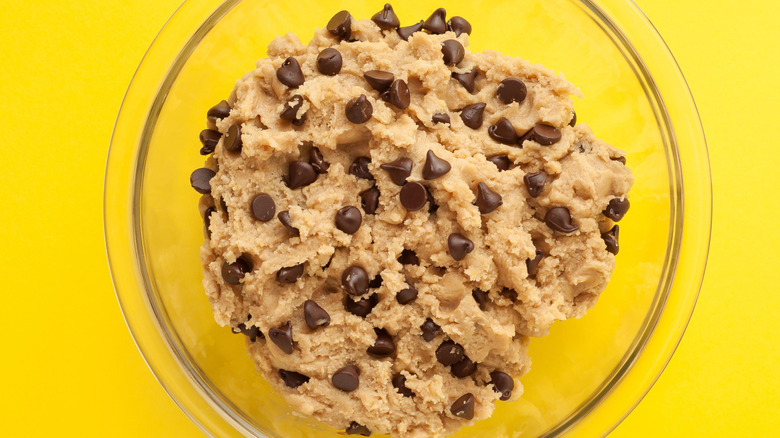
The aroma of freshly baked cookies wafting from the oven is undeniably tempting. Toll House cookie dough, a classic favorite, often beckons us to indulge in a spoonful before it even hits the baking sheet. However, it’s crucial to remember that while delicious, raw Toll House cookie dough can pose health risks due to its uncooked ingredients. This article will delve into the safety concerns surrounding raw cookie dough and provide essential tips for enjoying your favorite treat safely.
This guide will explore the potential dangers of consuming raw Toll House cookie dough, focusing on the risks associated with raw eggs and flour. We’ll discuss the presence of harmful bacteria like Salmonella and emphasize the importance of proper cooking instructions to ensure a safe and enjoyable baking experience.
Toll House Cookie Dough Safety
The safety of consuming Toll House cookie dough hinges on the fact that it contains raw ingredients, primarily eggs and flour, which can harbor harmful bacteria. While the thought of enjoying a spoonful of sweet dough might be tempting, it’s essential to prioritize your health and well-being by adhering to safe baking practices.
Remember, commercially produced Toll House cookie dough is specifically formulated for baking and not intended for raw consumption. The ingredients undergo processing that may not eliminate all potential risks associated with raw eggs and flour. Always consult the package instructions provided by the manufacturer for specific guidance on handling and consuming their product.
Raw Eggs and Flour Risks

Raw eggs are a common ingredient in Toll House cookie dough, contributing to its rich flavor and texture. However, raw eggs can carry Salmonella bacteria, which can cause foodborne illness characterized by symptoms such as fever, diarrhea, abdominal cramps, and vomiting. The risk of Salmonella contamination is particularly high with commercially produced eggs, as they may come into contact with contaminated surfaces during processing or transportation.
Similarly, raw flour, another key ingredient in Toll House cookie dough, can also harbor harmful bacteria like E. coli. Flour is typically milled from wheat grains that may have been exposed to bacteria during harvesting, storage, or transportation. While heat treatment during baking effectively kills these bacteria, consuming raw flour poses a significant health risk.
Salmonella Contamination
Salmonella is a common type of bacteria found in raw eggs and poultry products. It can also contaminate other foods, including flour, through cross-contamination during processing or handling. When consumed, Salmonella can cause food poisoning, leading to symptoms such as fever, diarrhea, abdominal cramps, and vomiting. In severe cases, Salmonella infection can lead to hospitalization or even death, particularly in young children, older adults, and individuals with weakened immune systems.
To minimize the risk of Salmonella contamination, it’s crucial to practice proper food safety measures when handling raw eggs and flour. Always wash your hands thoroughly with soap and water after handling these ingredients, and avoid cross-contamination by using separate cutting boards and utensils for raw and cooked foods.
Cooking Instructions

The most effective way to ensure the safety of Toll House cookie dough is to follow the package instructions carefully and bake it thoroughly. Baking at the recommended temperature for the specified time will kill any harmful bacteria present in the raw ingredients, making your cookies safe and delicious to enjoy.
Remember that undercooked cookie dough can still harbor harmful bacteria, so always check the internal temperature of your cookies using a food thermometer. The ideal internal temperature for baked cookies is 165°F (74°C).
Safe Baking Practices
Beyond following cooking instructions, several safe baking practices can further minimize risks associated with Toll House cookie dough:
Handwashing
Thoroughly wash your hands with soap and water before and after handling raw ingredients like eggs and flour. This simple step helps prevent the spread of bacteria.
Clean Surfaces
Clean all surfaces, utensils, and equipment that come into contact with raw cookie dough with hot soapy water. Disinfecting these surfaces after use can further reduce the risk of bacterial contamination.
Separate Utensils
Use separate cutting boards, knives, and spoons for handling raw ingredients and cooked foods to prevent cross-contamination.
Conclusion
While Toll House cookie dough is undeniably tempting, it’s crucial to prioritize safety when indulging in this sweet treat. Raw eggs and flour can harbor harmful bacteria like Salmonella, posing a risk to your health. By following proper cooking instructions, practicing safe baking habits, and adhering to food safety guidelines, you can enjoy delicious and safe Toll House cookies without compromising your well-being. Remember, a little caution goes a long way in ensuring a happy and healthy baking experience.
